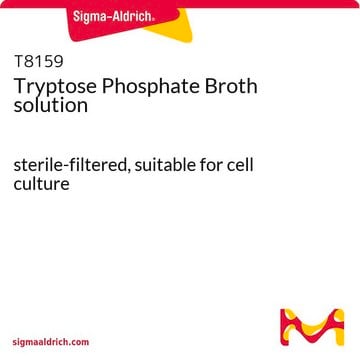Products may be shipped at a different temperature than the recommended long-term storage temperature. If the product quality is sensitive to short-term exposure to conditions other than the recommended long-term storage, it will be shipped on wet or dry-ice. If the product quality is NOT affected by short-term exposure to conditions other than the recommended long-term storage, it will be shipped at ambient temperature. As shipping routes are configured for minimum transit times, shipping at ambient temperature helps control shipping costs for our customers. For more information, please refer to the Storage and Transport Conditions document: https://www.sigmaaldrich.com/deepweb/assets/sigmaaldrich/marketing/global/documents/316/622/storage-transport-conditions-mk.pdf
T8787
Triton™ X-100
for molecular biology
Synonym(s):
t-Octylphenoxypolyethoxyethanol, Polyethylene glycol tert-octylphenyl ether
About This Item
Recommended Products
biological source
synthetic (organic)
Quality Level
grade
for molecular biology
description
non-ionic
form
liquid
technique(s)
protein purification: suitable
protein quantification: suitable
western blot: suitable
impurities
<1.00% water (Karl Fischer)
pH
9.7
mp
6 °C
transition temp
cloud point 65 °C
pour point ~7 °C
solubility
water: 0.1 mL/mL, clear to slightly hazy, colorless to faintly yellow
density
1.06 g/mL at 25 °C (lit.)
cation traces
Fe: <5 ppm
K: <0.05%
Na: <0.1%
heavy metals: <5 ppm
application(s)
hematology
histology
foreign activity
DNase and RNase, none detected
storage temp.
room temp
SMILES string
CC(C)(C)CC(C)(C)c1ccc(OCCOCCOCCOCCOCCOCCOCCO)cc1
InChI
1S/C28H50O8/c1-27(2,3)24-28(4,5)25-6-8-26(9-7-25)36-23-22-35-21-20-34-19-18-33-17-16-32-15-14-31-13-12-30-11-10-29/h6-9,29H,10-24H2,1-5H3
InChI key
HNLXNOZHXNSSPN-UHFFFAOYSA-N
Looking for similar products? Visit Product Comparison Guide
General description
Application
- In immunohistochemistry for staining the Flat-mount retinas[3]
- Along with ice-cold PBS (phosphate buffered saline) in suspension of cells for cell DNA analysis and Annexin V assay[4]
- To permeabilise cells during Immunofluorescent microscopic studies[5]
- As a positive control in LDH assay to determine the cell membrane integrity[6]
- For estimating the lipase activity in postheparin plasma by using modified Belfrage and Vaughan radioenzymatic procedure[7]
- For the preparation of outer membrane protein exctract[8]
- As a component of extraction buffer along with tris-HCl, NaCl, CaCl2, ZnCl2, Brij 35 for homogenization of mice lung cells[9]
- In the treatment of tissue sections for Immunofluorescence labeling[10]
Biochem/physiol Actions
Features and Benefits
- Ideal for sensitive molecular biology research applications
- Tested for DNase and RNase
- Non-ionic nondenaturing detergent
- Superior wetting agent and emulsifier
- Highly versatile surfactant
Other Notes
Legal Information
comparable product
Signal Word
Danger
Hazard Statements
Precautionary Statements
Hazard Classifications
Acute Tox. 4 Oral - Aquatic Acute 1 - Aquatic Chronic 1 - Eye Dam. 1 - Skin Irrit. 2
Storage Class Code
10 - Combustible liquids
WGK
WGK 3
Flash Point(F)
483.8 °F - closed cup
Flash Point(C)
251 °C - closed cup
Personal Protective Equipment
Choose from one of the most recent versions:
Certificates of Analysis (COA)
Don't see the Right Version?
If you require a particular version, you can look up a specific certificate by the Lot or Batch number.
Already Own This Product?
Find documentation for the products that you have recently purchased in the Document Library.
Protocols
Preparation for biodegradable nanoparticles and their use in transfection protocols .
Preparation for biodegradable nanoparticles and their use in transfection protocols .
Preparation for biodegradable nanoparticles and their use in transfection protocols .
Preparation for biodegradable nanoparticles and their use in transfection protocols .
Related Content
Cell lysis and protein extraction methods overview various techniques, from detergent solubilization to mechanical disruption, supporting research needs.
Cell lysis and protein extraction methods overview various techniques, from detergent solubilization to mechanical disruption, supporting research needs.
-
How is shipping temperature determined? And how is it related to the product storage temperature?
1 answer-
Helpful?
-
-
How can I determine the shelf life / expiration / retest date of this product?
1 answer-
If this product has an expiration or retest date, it will be shown on the Certificate of Analysis (COA, CofA). If there is no retest or expiration date listed on the product's COA, we do not have suitable stability data to determine a shelf life. For these products, the only date on the COA will be the release date; a retest, expiration, or use-by-date will not be displayed.
For all products, we recommend handling per defined conditions as printed in our product literature and website product descriptions. We recommend that products should be routinely inspected by customers to ensure they perform as expected.
For products without retest or expiration dates, our standard warranty of 1 year from the date of shipment is applicable.
For more information, please refer to the Product Dating Information document: https://www.sigmaaldrich.com/deepweb/assets/sigmaaldrich/marketing/global/documents/449/386/product-dating-information-mk.pdfHelpful?
-
-
What is the concentration of Triton X-1000 T8787?
1 answer-
This product is considered a neat or pure liquid at 100% active ingredient. The maximum allowable water content is 1%. This value is lot specific and reported on the Certificate of Analysis.
Helpful?
-
-
Hello, I am wondering how could I find the purity of the Triton X-100 in your products. Your help and advice is appreciated. Kind regards, Soheil
1 answer-
This product is 100 % active ingredient. The maximum allowable water content is 1 % for this product.
Please see the link below to review a sample Certificate of Analysis:
https://www.sigmaaldrich.com/certificates/sapfs/PROD/sap/certificate_pdfs/COFA/Q14/T8787-VAR0000267901.pdfHelpful?
-
-
Can pure Triton X-100 be stored at and remain stable at less than 4C?
1 answer-
This product has been subjected, in the pure form, to temperatures at or near the pour point (1 °C) with no degradation. At lower temperatures, the material may become viscous and require gentle warming to ensure homogeneity. In dilute solutions, such as cell lysates or protein samples, Triton X-100 is an excellent freeze/thaw stabilizer.
Helpful?
-
-
What form is this in?
1 answer-
This product is in liquid form at room temperature (melting point is 6 deg C) as listed in the "Properties" section of the product detail page.
Helpful?
-
Active Filters
Our team of scientists has experience in all areas of research including Life Science, Material Science, Chemical Synthesis, Chromatography, Analytical and many others.
Contact Technical Service






